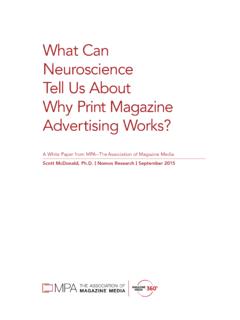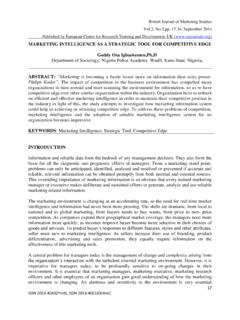Transcription of 13200 Reichheld INT - jihel.be
1 THE ULTIMATE QUESTIONFOR UNLOCKING THE DOOR TO GOOD PROFITS AND TRUE GROWTHFRED REICHHELDOne Question Can Determine Your Business s Future. Do You Know the Answer?CEOs regularly announce ambitious growth targets, then fail to achievethem. The reason? Their growing addiction to bad profits. These corporatesteroids boost short-term earnings but alienate customers. They underminegrowth by creating legions of detractors customers who complain loudlyabout the company and switch to competitors at the earliest loyalty expert Fred Reichheld shows how to reverse the equation,turning customers into promoters who generate good profits and true,sustainable growth. The key: one simple question Would you recommendus to a friend? that allows companies to track promoters and detractors andproduces a clear measure of an organization s performance through its customers eyes.
2 In industry after industry, this Net Promoter Score is the single most reliable indicator of a company s ability to grow. Based on extensive research, The Ultimate Questionshows how companiescan rigorously measure Net Promoter statistics, help managers improvethem, and create communities of passionate advocates that stimulateinnovation. Vivid stories from leading-edge organizations illustrate theideas in and compelling, this is the one book and the one tool no growth-minded leader can afford to miss. This is an advance, unedited page proof. Please note that changes may be made in these proofsbefore books are printed. If any material from the book is to be quoted in a review, the quotationshould be checked against the final bound book.
3 HARVARDBUSINESSSCHOOLPRESSD riving Good Profitsand True GrowthFRED REICHHELDB estselling author of THE LOYALTY EFFECTTHEHARVARD BUSINESS SCHOOL PRESSADVANCE EXCERPTULTIMATEQUESTION13200_Press_Reich ld Excrpt_CVR 11/15/05 1:55 PM Page 1 FRED REICHHELDis a Director Emeritus of Bain & Company, and in January 1999 waselected the firm s first Bain Fellow. Mr. Reichheldjoined Bain in 1977 and was elected to thepartnership in 1982. His consulting work andresearch have focused on helping clients achievesuperior results through improvements incustomer, employee, and partner loyalty. In theJune 2003 edition of Consultingmagazine, Mr. Reichheld was includedon the list of the world s top twenty-five Reichheld s work has been widely covered in the Wa l l S t r e e t Jo u r n a l ,New York Times, Fortune, Business Week,and the Economist.
4 TheEconomistrefers to him as the high priest of loyalty; the New YorkTimesdeclares, [He] put loyalty economics on the map. He is the authorof eight Harvard Business Reviewarticles on the subject, and his twoprevious books, The Loyalty Effect(1996) and Loyalty Rules (2001), werepublished by Harvard Business School Press. He is a frequent speaker tomajor business forums and groups of CEOs and senior graduate of Harvard College and Harvard Business School, Mr. Reichheldlives with his wife, Karen, and their family in the Boston area. HARVARDBUSINESSSCHOOLPRESSP ublication InformationDate: March 2, 2006 ISBN: 1-59139-783-9 Price: US$ Devoll, Senior RightsDaisy Blackwell Hutton, Assistant Director, Subsidiary SalesDiscounts available for quantity TrifiroSales advance orders call toll-free(888) 500-1016Or visit our website the , please contact your McGraw-Hill more information visit: Excrpt_CVR 11/15/05 1:55 PM Page 2 THEULTIMATEQUESTIONFor Unlocking the Door to Good Profits and True GrowthFRED REICHHELDHARVARD BUSINESS SCHOOL PRESSBOSTON, 11/11/05 10.
5 43 AM Page iPARWHPARHOWC opyright 2006 Harvard Business School Publishing CorporationAll rights reservedPrinted in the United States of America100908070654321No part of this publication may be reproduced, stored in or introduced into aretrieval system, or transmitted, in any form, or by any means (electronic,mechanical, photocopying, recording, or otherwise), without the prior permission of the publisher. Requests for permission should be directed to or mailed to Permissions, Harvard Business SchoolPublishing, 60 Harvard Way, Boston, Massachusetts 02163.[CIP TO COME]The paper used in this publication meets the minimum requirements of theAmerican National Standard for Information Sciences Permanence of Paper for Printed Library Materials, ANSI 11/11/05 10:43 AM Page iiCONTENTSP refaceixPART ONEWHY THE ULTIMATE QUESTION WORKS1 Bad Profits, Good Profits, and the Ultimate Question32 The Measure of Success 233 How NPS Can Drive Growth39 PART TWOHOW TO MEASURE RESPONSES4 The Enterprise Story: Measuring What Matters525 Why Satisfaction Surveys Fail776 The Rules of Measurement95r-oolr 11/11/05 10:43 AM Page iiiPART THREEBECOMING GOOD ENOUGH TO GROW7 Design Winning Customer Strategies1158 Deliver.
6 Building an Organization That Creates Promoters1379 Develop a Community of Promoters by Listening 15510 One Goal, One Number175 Appendix AThe Linkage Between NPS and Growth191 Appendix BWinners and Sinners for Selected Industries195 Acknowledgments197 Notes201 Index 205 About the Author209canthepanis bThemCodo 11/11/05 10:43 AM Page iv115137155175191195197201205209 ONEBad Profits, Good Profits, andthe Ultimate QuestionToo many companies these dayscan t tell the difference between good profits and bad. As a result,they are getting hooked on bad consequences are disastrous. Bad profits choke off a com-pany s best opportunities for true growth, the kind of growth thatis both profitable and sustainable.
7 They blacken its pursuit of bad profits alienates customers and profits also make a business vulnerable to that are not addicted yes, there are many can anddo zoom right past the bad-profits junkies. If you ever wonderedhow Enterprise Rent-A-Car was able to overcome big, well-entrenched companies to become number one in its industry, howSouthwest Airlines and JetBlue Airways so easily steal market sharefrom the old-line carriers, or how Vanguard soared to the top 11/11/05 10:43 AM Page 3the mutual fund industry, that s your answer. These companiesjust said no to bad profits, and their revenues and reputations cost of bad profits extends well beyond a company sboundaries.
8 Bad profits provide a distorted picture of businessperformance. The distortion misleads investors, yielding poorresource decisions that hurt our economy. Bad profits also tarnishthe position of business in society. That tarnished reputationundermines consumer trust and provokes calls for stricter rulesand tighter regulations. So long as companies pursue bad profits,all the noisy calls for better business ethics are so much hot air. Theonly way a company can truly live by the Golden Rule treat oth-ers as you would like to be treated is to avoid bad profits now you re probably wondering how in heaven s name profit,that holy grail of the business enterprise, can ever be bad. Short ofoutright fraud, isn t one dollar of earnings as good as another?
9 Cer-tainly, accountants can t tell the difference between good and badprofits. They all look the same on an income bad profits don t show up on the books, they are easy torecognize. They re profits earned at the expense of a customer feels misled, mistreated, ignored, orcoerced, then profits from that customer are bad. Bad profits comefrom unfair or misleading pricing. Bad profits arise when compa-nies save money by delivering a lousy customer experience. Badprofits are about extracting value from customers, not creatingvalue. When sales reps push overpriced or inappropriate productsonto trusting customers, the reps are generating bad profits. Whencomplex pricing schemes dupe customers into paying more thannecessary to meet their needs, those pricing schemes are con-tributing to bad tbe couninciseaw4 PART I: WHY THE ULTIMATE QUESTION 11/11/05 10:43 AM Page 4niesaveny sessoorishionulesfits, ,t ofer-bady tomerormepa-Badingctshenhanon-You don t have to look far for examples.
10 Financial servicesfirms, for instance, like to throw around terms like fiduciaryandtrustin their advertising campaigns, but how many firms deservethese monikers? Mutual funds bury their often-exorbitant admin-istrative fees in the fine print, so that customers won t know whatthey re paying. Brokerage firms slant their research to supportinvestment-banking clients, thus bilking their stock-buying banks charge astonishing fees for late payments or take health care. Too many hospitals won t reveal the dealsthey have cut with insurance companies. Too many insurers dotheir best to exclude people who might actually need the cover-age and if you do have coverage, they re sure to drown both youand your doctor in a deluge of complicated paperwork.




